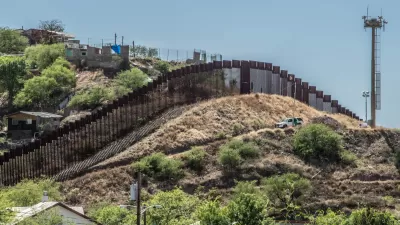The original purpose of President Trump's press conference were lost as the discussion devolved.

Hallie Busta reports on the executive order signed by president Donald Trump on August 15, 2016, "concerning the environmental review and permitting process for infrastructure projects."
"The order nixes the Obama-era Federal Flood Risk Management Standard, which set higher resiliency standards for projects that receive federal funds and are vulnerable to sea-level rise," according to Busta. Valerie Volcovici and Jeff Mason report in a separate article on those features of the executive order.
Busta also notes that President Trump "unfurled a flowchart that he said detailed the new approvals process for federal highway projects," during the press conference.
Although the flow chart was largely unreadable during the press conference, an article by Annalisa Merelli later followed up with an article that presents the flow chart in digital form. "The president had showed this chart in April, and he did so again today (Aug. 15), together with a shorter version without the many steps he plans to cut," reports Merelli.
The infrastructure revelations of a press conference soon became mired in controversy over the president's reactions to the violence in tragedy in Charlottesville, Virginia the previous weekend, but according to Busta's take on the executive order and the flow chart, there is still very little detail about the $1 trillion investment President Trump has repeatedly promised for the nation's infrastructure.
FULL STORY: Trump signs executive order to streamline infrastructure approvals

Maui's Vacation Rental Debate Turns Ugly
Verbal attacks, misinformation campaigns and fistfights plague a high-stakes debate to convert thousands of vacation rentals into long-term housing.

Planetizen Federal Action Tracker
A weekly monitor of how Trump’s orders and actions are impacting planners and planning in America.

San Francisco Suspends Traffic Calming Amidst Record Deaths
Citing “a challenging fiscal landscape,” the city will cease the program on the heels of 42 traffic deaths, including 24 pedestrians.

Defunct Pittsburgh Power Plant to Become Residential Tower
A decommissioned steam heat plant will be redeveloped into almost 100 affordable housing units.

Trump Prompts Restructuring of Transportation Research Board in “Unprecedented Overreach”
The TRB has eliminated more than half of its committees including those focused on climate, equity, and cities.

Amtrak Rolls Out New Orleans to Alabama “Mardi Gras” Train
The new service will operate morning and evening departures between Mobile and New Orleans.
Urban Design for Planners 1: Software Tools
This six-course series explores essential urban design concepts using open source software and equips planners with the tools they need to participate fully in the urban design process.
Planning for Universal Design
Learn the tools for implementing Universal Design in planning regulations.
Heyer Gruel & Associates PA
JM Goldson LLC
Custer County Colorado
City of Camden Redevelopment Agency
City of Astoria
Transportation Research & Education Center (TREC) at Portland State University
Jefferson Parish Government
Camden Redevelopment Agency
City of Claremont





























